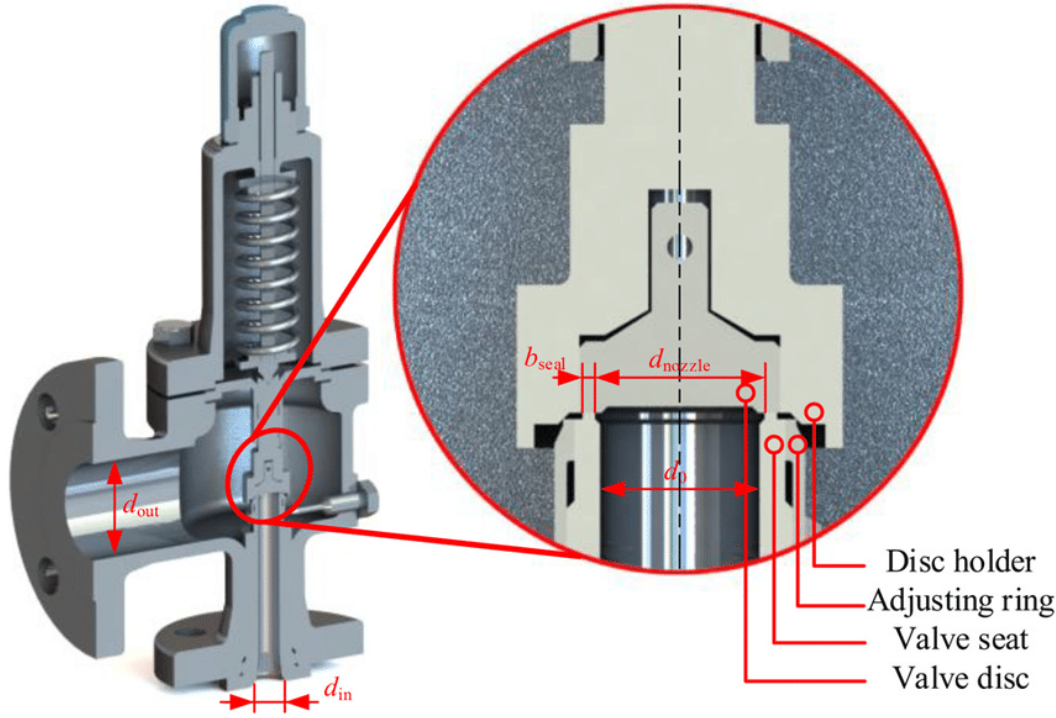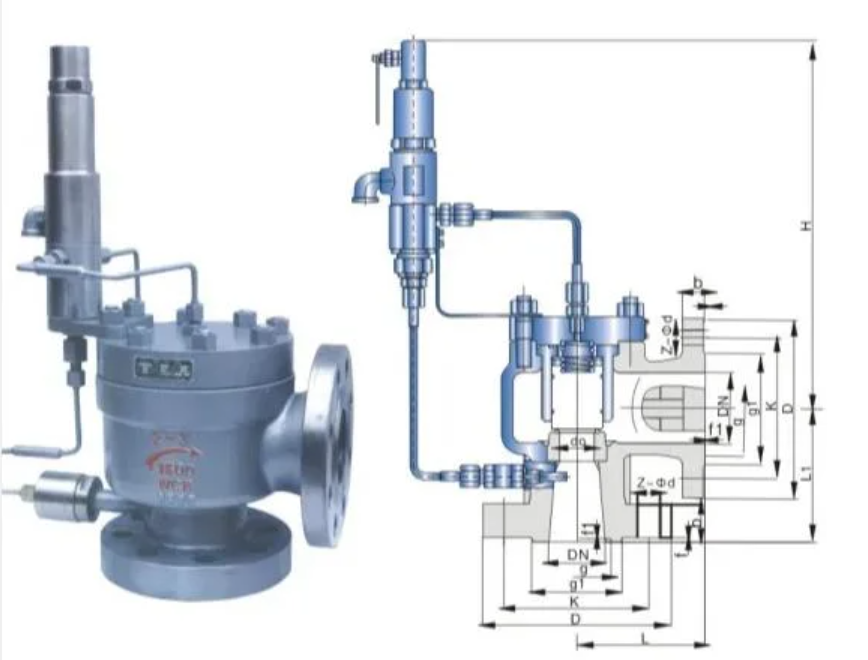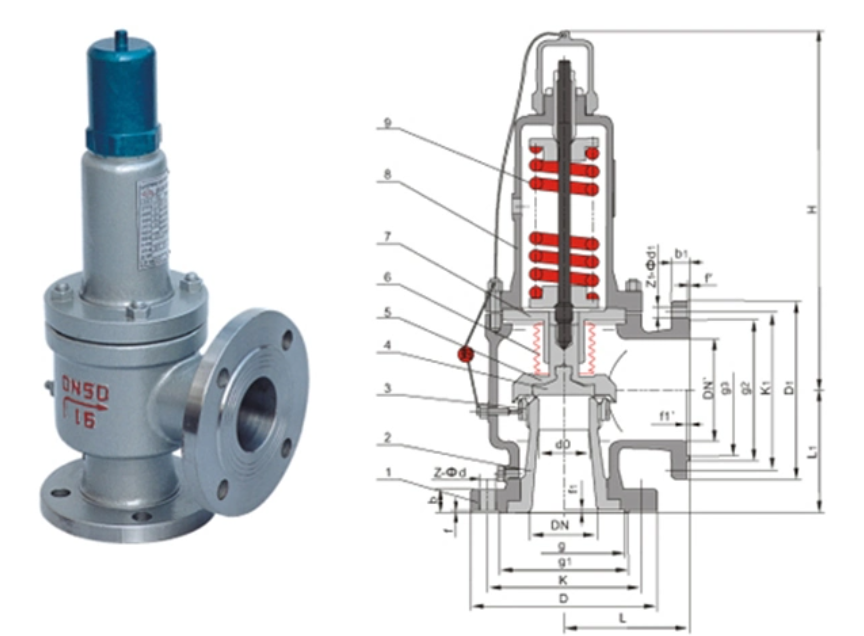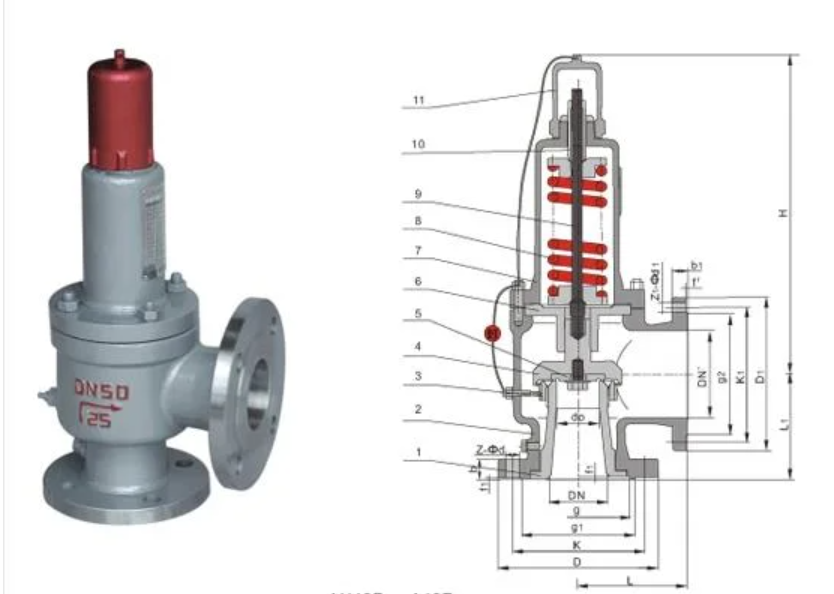These ingenious small mechanisms are made to open at a predefined set pressure in order to shield equipment from pressures higher than what is safe for it. Whoosh! When the predetermined pressure is attained! By opening the valve, the process fluid is able to exit the system and prevent an explosion from occurring. Similar like your reliable companion, right?
The valve shuts, stopping additional fluid flow, when the pressure returns to a safe level. This is because, in normal circumstances, the main valve is held in place by spring tension. A PRV's opening and closing pressures are typically the same, but occasionally they could differ just a little. The closing pressure may be slightly less because to a phenomenon known as "hysteresis." But we'll talk about that later.
The best part is that a pressure relief valve's main function is self-actuation. Yes, there's no need for an outside force. It all comes down to the valve's setup and pressure. Very clever, huh?
Let's clear up a few things before continuing. It's possible to hear "safety valve" and "pressure relief valve" used interchangeably. Even though they are somewhat similar, they differ significantly from one another.
When the system pressure increases, a pressure relief valve, or PRV, is made to open gradually, letting fluid out bit by bit. However, when the pressure beyond the predetermined limit, a safety valve (also known as a safety relief valve) instantly opens. Imagine it as much more controlled and less messy than a drink can popping open.
Therefore, safety relief valves and pressure relief valves (PRVs) are included in the discussion of pressure relief valve types. Well, enough small talk. Let's examine the various kinds of pressure relief valves!
The spring-loaded variety of pressure relief valves is the first in our extensive tour of them. Now, don't be misled by the name; these valves don't actually contain springs. Not in the way you might imagine, though.
Here, "spring-loaded" refers to the valve's construction. Under typical circumstances, a spring force is used to hold the valve closed. The valve opens to let extra process fluid escape when the system pressure rises above the force applied by the spring (the set pressure). The valve then shuts off after the pressure returns to a safe level. Very cool, huh?
These are the most widely used kinds of pressure relief valves, and you may find them in a lot of different places, like piping systems, boilers, and pressure vessels. The nicest thing about them is that they don't need an external power source, making them dependable and simple to use. Yes, they have self-actuation.

The pressure relief valves that are pilot-operated come next. Although these are a little more intricate than their spring-loaded equivalents, they are also more adaptable. Permit me to clarify.
A secondary valve, known as the "pilot," controls the main valve in a pilot-operated valve. Depending on the system pressure, the pilot valve opens or closes. The primary valve's function is then under the control of this. Very cool, eh?
But you might wonder, what good is a pilot valve? More precise control over the set pressure is made possible by the pilot-operated valve's design. This means that systems with extremely high pressures or those where even a tiny leak could have disastrous consequences can employ the valve. You may visualize it by thinking of nuclear power plants.

As the name implies, temperature is the main factor in all of these valves. When the process fluid's temperature rises over a predetermined point, they are meant to open. They are therefore ideal for systems where heat accumulation may be an issue.
Pressure relief valves that are temperature-activated often operate on their own without the need for an additional power source. They are most frequently found in hot water tanks and heating systems, or any other location where an abrupt change in temperature could send pressure into disarray.
Consider a pressure relief valve that is spring-loaded. Imagine that valve now has a bellows added to it. In a word, that is a balanced bellows pressure relief valve.
The bellows is an adaptable part that travels with the valve disc and resembles an accordion. These valves are perfect for systems where back pressure varies because of their design, which helps to balance out the influence of back pressure on the valve's function.

Not to be overlooked are pressure relief valves with nozzle designs. These are a little different now. These valves employ a nozzle and orifice to regulate the flow of process fluid rather than a disc and seat.
Nozzle type valves are frequently utilized in systems with particulate-filled or unclean fluid. The valve's construction keeps it from being clogged, guaranteeing dependable operation even in challenging circumstances.

There are numerous designs for pressure relief valves, and each has special benefits and drawbacks. The particulars of the application and the state of the system determine the best kind of valve. When choosing a pressure relief valve, it's important to take into account the following important factors: cost, operating conditions, permitted backpressure, fluid characteristics, necessary set pressure, and maintenance requirements. The following table compares different types of pressure relief valves and highlights the main advantages and disadvantages of each design:
| Valve Type | Advantages | Disadvantages |
| Spring-Loaded Relief Valves | * Simple and reliable design * Suitable for wide range of applications * Self-actuated – no external power required |
* Sensitive to back pressure * May not handle very high pressures |
| Pilot-Operated Relief Valves | * Allow precise control of set pressure * Can handle very high pressures * Less prone to chattering |
* More complex design * Higher maintenance requirements * Increased cost |
| Temperature-Activated Relief Valves | * Activated by rise in temperature * Do not require external power * Suited for systems prone to heat build-up |
* May not respond quickly to sudden pressure spikes |
| Balanced Bellows Relief Valves | * Can accommodate fluctuating back pressure * Bellows balances effects of back pressure |
* Potential for bellows wear or damage * Higher cost than basic spring-loaded valves |
| Nozzle Type Relief Valves | * Resistant to clogging from dirty fluids * Reliable in applications with particulates |
* More expensive than other designs * Increased complexity and maintenance |
| Piston-Type Relief Valves | * Handle very high pressures * Extremely accurate set pressures |
* Complex design * Prone to wear and erosion * Require regular maintenance |
| Diaphragm-Type Relief Valves | * Excellent for liquid service * Balanced design * Rapid opening |
* Potential for diaphragm damage * Generally higher cost |
Because they can change in volume under pressure, gas and air are compressible materials. However, no matter how much pressure is applied, the volume of liquids remains constant because they are incompressible. Therefore, some engineering dexterity is needed when handling these various fluid kinds.
Air and gas safety relief valves are often configured to open at a pressure that is marginally higher than the system's maximum pressure. This keeps the valve from chattering, or opening and closing quickly as a result of tiny pressure changes.
Conversely, liquid safety relief valves require a slightly different methodology. Usually, they are configured to open at a pressure slightly less than the highest system pressure that is permitted. This is due to the fact that an abrupt increase in liquid pressure can result in water hammer, a shock wave that can harm machinery.
After getting to know the many kinds of pressure relief valves, let's discuss choosing the appropriate pressure setting. It's similar to determining the ideal oven temperature: if you set it too high, your cake might burn, and if you set it too low, it might not cook at all.
A pressure relief valve's "set pressure" is the pressure at which it begins to open. Typically, it is adjusted to a value that is somewhat higher than the equipment it is safeguarding's maximum acceptable working pressure (MAWP).
Remember that the goal is not to sustain a specific pressure, but rather to stop the pressure from rising above the equipment's design limit. Thus, the set pressure needs to be both high enough to prevent needless openings and low enough to shield the machinery from overpressure.
Pressure relief valves are composed of a very durable material. Given the work they do, they must be. What precisely are they constructed of, though?
The majority of pressure relief valves are constructed from cast iron, bronze, or stainless steel. These substances have been selected due to their robustness, longevity, and capacity to withstand corrosion. Ultimately, you don't want your valve to corrode or malfunction when you least expect it to.
The primary valve (or disc), the seat, the spring, the bonnet, and – in certain valves – the bellows are the essential parts of a pressure relief valve. Every part plays a specific role in the valve's operation. For instance, the spring provides the force required to keep the main valve closed in typical operating conditions, while the main valve regulates the flow of process fluid.
Let's now discuss installing these tiny heroes. A pressure relief valve is not something you can just plop down and hope works. No, there are a few important points to remember.
First, the valve must be mounted on the pressured vessel or at the system's highest point. This is so because the fluid's static pressure, which is greatest at the system's lowest point, is what drives the operation of pressure relief valves.
Second, the valve must have its output side either linked to a discharge pipe or left open to the atmosphere, and its inlet side must be connected to the system. Additionally, you must ensure that the piping does not impede the fluid flow from the valve.
Finally, the bonnet must be positioned atop the vertically fitted pressure release valves. This will let the process fluid escape the valve and stop any accumulation.
Pressure relief valves require some maintenance to keep them in good condition, just like any other piece of machinery. The life of the valve can be increased and failure can be avoided with routine maintenance and inspections.
Inspections often entail examining the valve for indications of wear or damage, as well as examining the set and relieving pressures. However, maintenance might also involve recalibrating the set pressure, replacing worn-out parts, and cleaning the valve.
Remember that safety relief valves are there to keep you safe. Therefore, spending the time to take care of them is well worth it.
| Application | Description |
| Piston Compressors | On cylinder heads, piston safety valves guard against overpressurization damage. When process pressure climbs over the prescribed pressure, the piston rises against a calibrated spring, letting extra gas escape. |
| Diaphragm Safety Valves | Diaphragm valves have accurate, dependable pop action. When the inflow pressure is greater than the spring force, the diaphragm opens. The diameter of the outlet port is chosen for the needed flow rate at maximum lift. |
| Conventional Safety Relief Valves | Include the main valve, spring housing, output port, and intake nozzle. For increased set pressure accuracy, pilot-operated variants have an external pilot to regulate the main valve's opening. |
| Oil & Gas, Chemical, Power Generation, Manufacturing | Prevent catastrophic device failures caused by high internal pressure. must fulfill strict industry requirements, particularly in warm conditions. |
| ASME BPVC Section VIII | specifies the materials, testing, and design criteria for safety valves used in boilers, pressure vessels, and pipelines in the United States. valves stamped with an MAWP-based set pressure. |
| Liquid Service | Set pressure just under waterline rating to avoid chatter. |
| Forced-Flow Steam Generators | Set pressure exceeds fixed steam dome pressure. |
| Dome Pressure Chambers | Pilot-operated valves allow tighter set pressures for large bore diameters. |
| Bellows Safety Relief Valves | Adapt nicely to different backpressures. Guard against excessive internal vacuum and pressure. |
| Inspection, Testing & Maintenance | Important in all industries to guarantee correct operation when needed and to prevent failure. Defend people and property. |
Thus, the next time you're by a pipeline or a boiler, stop and consider how simple the pressure relief valve is. Even while it doesn't seem like much, it is performing a very crucial function.
Our exploration of the world of pressure relief valves comes to an end there. But keep in mind that this is only the beginning. There is a vast array of valves available, each with distinct features and purposes. Thus, never stop exploring—you never know what you might find!
